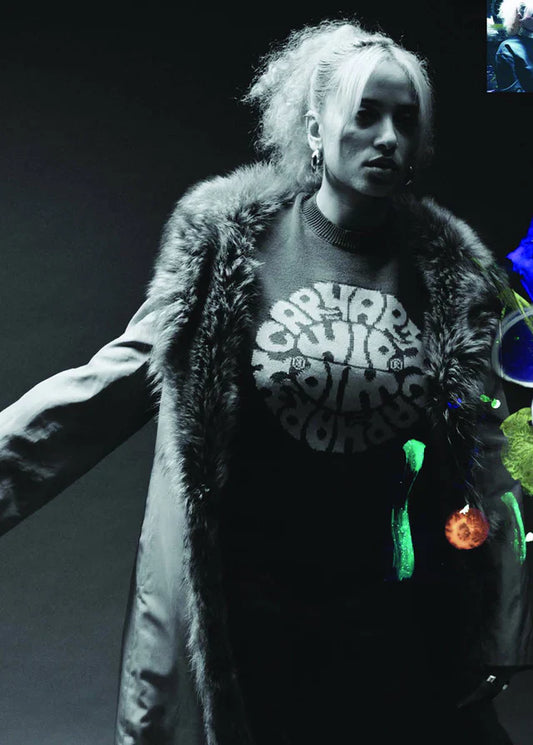At the tail end of the year 2000, artist Scott King was asked to redesign Sleazenation. Despite hating the magazine, the draw of previous star art director Stephen Male, combined with hubris, made him take the job. For the latest issue of WIP magazine, he explains how he overhauled the entire publication, while setting it up for failure.
Words: Scott King
It was November of the new Millenium and I’d be lying if I said I knew what I was doing. I had been the art director of i-D, true. But this was a different problem. I didn’t like the way Sleazenation was designed, I didn’t like much of the photography, and if I’d learned anything at all about fashion while at i-D, it was only that you couldn’t do it second rate: you either needed the very best fashion photographers and stylists, or you shouldn’t bother.
But it’s easy to hate anything. More challenging is; how do you actually make it better? I couldn’t just adjust it, I had to start again.
I spent a month sitting in front of a big screen in the Sleazenation office. I had it in mind that the magazine should be ‘bookish’ – austere and adult, in contrast to its subject matter.
Late one night, leaving the office after I’d been working on some spreads, I realized I’d forgotten my house keys, so I went back. There were several people gathered around the computer that I’d been working on, unaware that I was now standing behind them. One of them pointed at something I’d done and said, “This is shit. It looks like a Sunday supplement.” And it did.
I overhauled the entire thing. I spent the next week stripping down the design. I’d use only two typefaces – typefaces that every computer in the world had as standard: Times and Helvetica. My thinking was that this was ‘punk’ – just using the tools you were given, no wanky design stuff. I’d also only use one color for the type: black. This cut out lots of decision making, and I’m terrible with colors. Next, still reeling from Sunday supplement, I got rid of all their photographers. I called up my friends, ones who wouldn’t normally have worked on a small style magazine – snobs, like me – and I explained my situation: this was to be a totally new magazine, nothing like what it used to be. This was to be a masterpiece!

If I had to pinpoint it, this is probably when I started to become dictatorial. A megalomania still fuelled by Sunday supplement. I began to imagine myself to be omnipotent – “this is MY magazine.” I’d gone from reluctant snob, pussyfooting around with the design, to self-appointed in-house genius — somewhere between George Lois and Idi Amin.
I quickly forgot that I’d only been asked to do a redesign of the magazine — it wasn’t my job to do anything more than hand over a series of designs that showed how future covers might work, or how best to layout a fashion story. I became obsessive, convinced that, under my dictatorship, we could make the best magazine in the world.
It’s strange to look back on this now. I was 30 years old and spent most of my life in the pub. I’d sit there with my notebook, fags and pint and scribble out ideas for future magazine covers, or harebrained schemes for how the magazine was not actually a magazine, but a rock group. It would take on the establishment, it would make a mockery of both the media and the total trivia on which style mags were built… It would be, I once wrote in my notebook, “A Pistol with which to shoot ourselves in the foot.”
I asked the editor and the publisher to let me stay on, and they were happy for me to do so, delighted even. Not least because I told them I didn’t care about being paid; I’d just received a small fortune for a job I’d done, enough money to live on for a year, and I had it in mind that I would do Sleazenation for a tiny salary. In my mind this was an unspoken pact: “I work for peanuts and in return you let me do what I want.”
I didn’t tell them my secret plan, which was to get Sleazenation banned from the shelves. A style mag that is so ‘punk rock’ that it’s banned from WH Smiths.
Nobody seemed to really know what they were doing at the magazine. Nobody knew how to get decent advertising, and nobody seemed to care.
Photoshoots were often commissioned, and then came out so badly that they had to be dropped. Anywhere else this would be a nightmare, but I considered it a Godsend. It meant I could fill those blank pages with whatever I wanted. This is how things like ‘Epidemic: A Fashion Story’ came about; a story that was built around press shots of English football hooligans abroad, with all their clothing researched and listed as fashion credits: ‘Bleeding England fan wears jeans by Armani’; ‘Chair throwing England fan wears replica Accrington Stanley Football Club shirt.’ This went on for 18 months. Total – and even necessary – creative freedom. Filling in the gaps left by failed commissioned content.
Of course it couldn’t last. Sleazenation was getting a lot of recognition, especially for the covers, but it wasn’t selling well, and the advertising was down. (Surprising really: Why don’t Gucci want to take out ads in a magazine with a man seemingly having sex with a pig on the cover?)
It was decided that my approach was ‘non-commercial’ and that I must go – so they fired me. I was hurt at the time, but in retrospect, what did I expect?
The magazine went from strength to strength after my departure, going on to sell millions of copies worldwide… (Not really, it folded soon afterwards.)


 Europe
Europe









